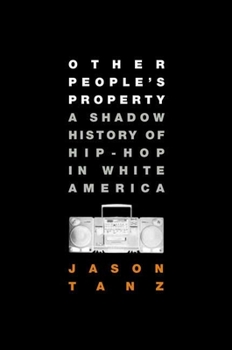Other People's Property: A Shadow History of Hip-Hop in White America
Over the last quarter-century hip-hop has grown from an esoteric form of African-American expression to become the dominant form of American popular culture. Today, Snoop Dogg shills for Chrysler and... This description may be from another edition of this product.
Format:Hardcover
Language:English
ISBN:1596912731
ISBN13:9781596912731
Release Date:February 2007
Publisher:Bloomsbury USA
Length:272 Pages
Weight:0.95 lbs.
Dimensions:1.0" x 5.8" x 8.5"
Customer Reviews
3 ratings
OPP: A journey through rap, race and the making of a cultural moment
Published by Thriftbooks.com User , 17 years ago
Hip-hop music, what some of us still think of as "rap," isn't easy to sort out these days. It seems to have invaded all aspects of life, even in the seemely far-removed and lilly-white suburbs. So what counts today as "authentic" hip-hop? Is it necessarily black? If it's commercialized to identify with a product, say Sprite, does that make the rapper a "sellout?" And if you're white, suburban and, say, over 35, what is hip-hop culture all about? These, it turns out, are exceedingly complicated questions. They cut deeply to the root of what was once a raw expression of black realism to a place where, even within hip-hop, debates rage. But Jason Tanz, a rap-loving white kids from suburban Tacoma, Wash., has some surprising and fascinating answers for you in this thoughtful book with a perfect title -- Other People's Property. Tanz takes us on an illuminating journey from rap's emergence among graffiti artists and break dancers on the streets of the Bronx, through his own experience as a sometimes guilt-ridden rap music lover cocooned in safe, white suburia, to today's wildy diverse and commercially bankable hip-hop scene. Tanz personal story will, in turns, make you cringe, laugh and cheer. But his look at rap's varied charecters is what will keep you turning the pages. There's Grandmaster Flash's Rahiem, an icon of rap's roots on New York City's rough streets, now a "Legends of Hip-Hop" tour guide busing white fans through the Bronx for $75 a pop. There's Papa Rich, an authentic NYC street performer who teaches break dancing to the wealthy suburban children of Connecticut's soccer moms. There's Tha Pumpsta, an earnest white rap lover who misses entirely the irony when he DJ's "kill whitie" parties in the Virginia suburbs. And there's MC Frontalot, a comical hip hop anti-hero who excites nerdy white fans with his brand of "Geeksta" rap. Tanz travels to Green Bay to explore a rap radio experiment in one of America's whitest cities and to a garage studio in suburban L.A. where a group of goofy white losers play act the part of black gangsters. More than anything, this is a smart book. The anecdotes carry the story, but Tanz peppers in sharp analysis and displays a deep understanding of the delicate balances -- and sometimes blatant contradictions -- of race, culture, commerce and sincerity (or a lack of it) in hip-hop. And if you ever wondered how we got here, to an America where hip-hop music and style dominate the mainstream, Tanz's book takes you through it all with both unblinking criticism and fond affection. In a brilliant chapter on the marketing of hip-hop, Tanz concludes rap has has the potential, perhaps untapped, to be a cultural bridge between white and black America: "Inner city black kids, seeking a modicum of respect and financial security, create a point of entry into the commerical world that has ignored them for so long. We white kids, drawn to the implicit escape that their music and lifestyles represented, bought it.
A hard-hitting analysis
Published by Thriftbooks.com User , 18 years ago
OTHER PEOPLE'S PROPERTY; A SHADOW HISTORY OF HIP HOP IN WHITE AMERICA could also have appeared in our 'Social Issues' section but is reviewed here for its focus on the obstacles that stand between producers and consumers of rap music: a very different approach than your usual music book covering the history of rap and the evolution of rapsters. It blends a personal story of growing up in a racially divided America with cultural analysis and music insights: while this approach might defy easy categorization, it does make for a hard-hitting analysis which will reach not only college-level collections strong in social issues and music, but the general-interest public and libraries with holdings strong in ethnic issues debates.
Very impressed!
Published by Thriftbooks.com User , 18 years ago
I picked up this book because I like hip hop, but didn't really understand the incredibly interesting larger cultural and social context in which it arose and operates. Having read my fair share of books on jazz, I was concerned because I know authors can take great art forms and turn them into boring academic treastises. Thankfully, Jason Tanz has richly and engagingly captured an inner city art form and its often uncomfortable, yet strangely symbiotic, relationship with white middle America. Norman Mailer, Thoreau and Eminem all make an appearance as Tanz entertainingly traces the origins of hip-hop and the way it has influenced, but also been subverted by, the white audience and market.





